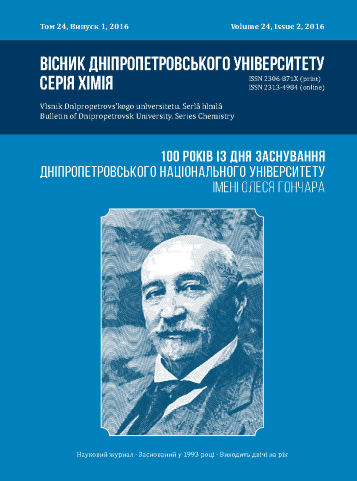The salting-out of molibdoferrats(II) from aqueous solutions by the organic solvents
DOI:
https://doi.org/10.15421/081615Keywords:
molybdoferrates(II), асetone, solubility, dielectric constantAbstract
The aim of this work was to develop a method for producing of molybdoferrate(II) precipitates by salting-out them from aqueous solutions by means of organic solvents. Dependence of the composition of molybdoferrate(II) precipitates on the pH of the reaction solutions was studied. Experiments on salting-out of molybdoferrate(II) with various organic solvents were carried out. As a result it was found that the best reagent for the molybdoferrate(II) salting-out is acetone. By its use, lowest quantity of the ammonium sulfate impurities was obtained. It is also of importance that by using of acetone the process of regeneration by distillation of the reaction solutions is characterized by the lowest energy consumption. A functional relationship between the solubility of molybdoferrates(II) and dielectric constant of the medium was established. By increasing the dielectric constant of the solvent solubility of molybdoferrates(II) rapidly increases. The linearized dependence ln(lnS)–ln(1/e) was proposed to predict the solubility of molybdoferrates(II) in various aqueous-organic solutions.References
Nikolenkо, N. V., Kozhevnikov, I. V., Kostyniuk, A. O., Bayahia, H., & Kalashnykov, Yu. V. (2016). Preparation of iron molybdate catalysts for methanol to formaldehyde oxidation based on ammonium molybdoferrate(II) precursor J. Saudi Chem. Soc. (in the press). doi:10.1016/j.jscs.2016.04.002 CrossRef
Nikolenko, M. V., Kostynyuk, A. O., Goutenoire, F., & Kalashnikov, Yu. V. (2014). Chemical Precipitation of Iron(III) Molybdate + Molybdenum Trioxide Mixtures through Continuous Crystallization. Inorg. Mater., 50(11), 1140–1145. doi:10.1134/S0020168514110120 CrossRef
Kostynyuk, A. O., Gutenuar, F., Kalashnikova, A. N., Kalashnikov, Yu. V., & Nikolenko, N. V. (2014). Kinetics of the Thermal Treatment of an Iron–Molybdenum Catalyst. Kinet. Catal., 55(5), 649–655. doi:10.1134/S0023158414050073 CrossRef
Jin, G., Weng, W., Weng, Z., Dummer, N., Taylor, S., Kiely, C., Bartley, J., & Hutchings, G. (2012). Fe2(MoO4)3/MoO3 nano-structured catalysts for the oxidation of methanol to formaldehyde. J. Catal., 296, 55–64. doi:10.1016/j.cat.2012.09.001 CrossRef
Nikolenko, N. V., Kostynyuk, A. O., Kalashnikov, Yu. V., & Cheremis, E. A. (2012). The Calculation of the Thermodynamic Equilibrium in the System Fe3+/MoO42–/H+(OH–)/H2O and Determination of the Reasonable Conditions for the Deposition of Iron Molybdate. Russ. J. Appl. Chem., 85(12), 1814−1819. doi:10.1134/S107042721212004X CrossRef
Bowker, M. (2015). Rules for Selective Oxidation Exemplified by Methanol Selective Oxidation on Iron Molybdate Catalysts. Top. Cat. 58 (10), 606–612. doi:10.1007/s11244-015-0399-4 CrossRef
Bowker, M., Gibson, E. K., Silverwoodad, I. P., & Brookesab, C. (2016). Methanol oxidation on Fe2O3 catalysts and the effects of surface Mo. Faraday Discuss. 188, 387–398. doi:10.1039/C5FD00225G CrossRef
Brookes, C., Bowker, M., & Wells, P. P. (2016). Catalysts for the Selective Oxidation of Methanol. Catalysts, 6, 92–119. doi:10.3390/catal6070092 CrossRef
Pop, M. S. (1990). Heteropoly- and isopolyoxometallates. – Novosibirsk, USSR: Science (in Russian).
Ammam, M. (2013). Polyoxometalates: formation, structures, principal properties, main deposition methods and application in sensing. J. Mater. Chem., 1(21), 6291–6312. doi:10.1039/C3TA01663C CrossRef
Minkin, V. I., Simkin, B. Ya., & Minyaev, R. M. (1990). Quantum Chemistry of Organic Compounds: Mechanisms of Reactions. – Berline, Germany: Springer-Verlag. doi:10.1007/978-3-642-75679-5 CrossRef
Belousov, V. P., & Panov, M. Y. (1983). Thermodynamics of aqueous solutions of nonelectrolytes. − Leningrad, USSR: Chemistry (in Russian).
Hine, J., & Mookerjee, P. K. (1975). Structural effects on rates and equilibriums. XIX. Intrinsic hydrophilic character of organic compounds. Correlations in terms of structural contributions. J. Org. Chem, 40(3), 292–298. doi:10.1021/jo00891a006 CrossRef
Hall, G. G. (1989). The Lennard-Jones lecture. The continuing importance of electrostatics in chemistry. J. Chem. Soc., Faraday Trans. 2, 85(4), 251–260. doi:10.1039/F29898500251 CrossRef
Gadre, S. R., & Bhadane, P. K. (1999). Electrostatics in chemistry 2. Electrostatic potentials of atoms, ions and molecules. Reson., 4(5), 40–51. doi:10.1007/BF02834319 CrossRef
Downloads
Published
Issue
Section
License
Copyright (c) 2016 Oles Honchar Dnipropetrovsk National University

This work is licensed under a Creative Commons Attribution 4.0 International License.
- Authors reserve the right of attribution for the submitted manuscript, while transferring to the Journal the right to publish the article under the Creative Commons Attribution License. This license allows free distribution of the published work under the condition of proper attribution of the original authors and the initial publication source (i.e. the Journal)
- Authors have the right to enter into separate agreements for additional non-exclusive distribution of the work in the form it was published in the Journal (such as publishing the article on the institutional website or as a part of a monograph), provided the original publication in this Journal is properly referenced
- The Journal allows and encourages online publication of the manuscripts (such as on personal web pages), even when such a manuscript is still under editorial consideration, since it allows for a productive scientific discussion and better citation dynamics (see The Effect of Open Access).


